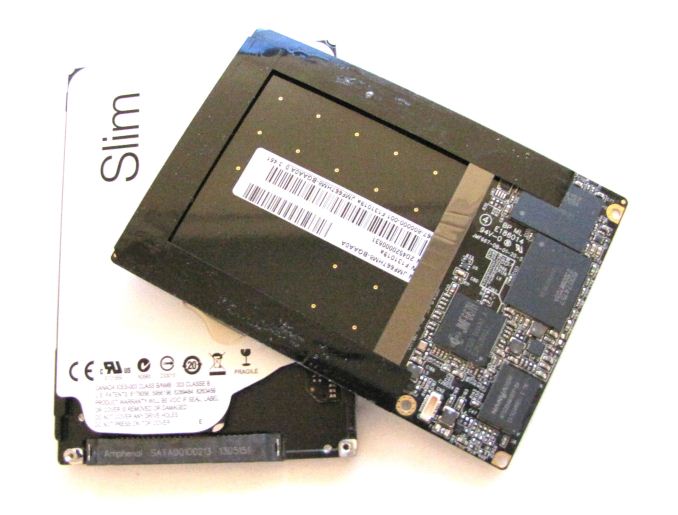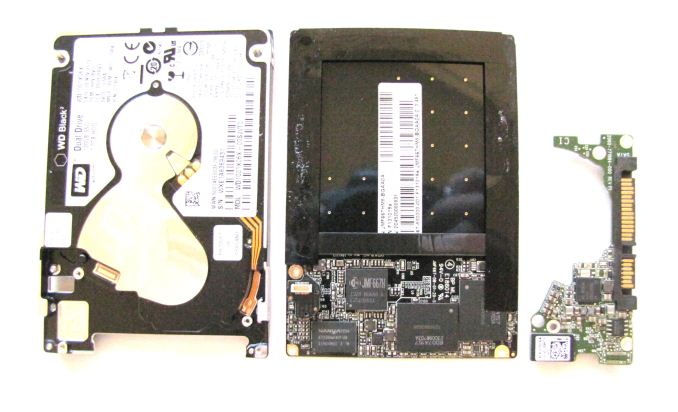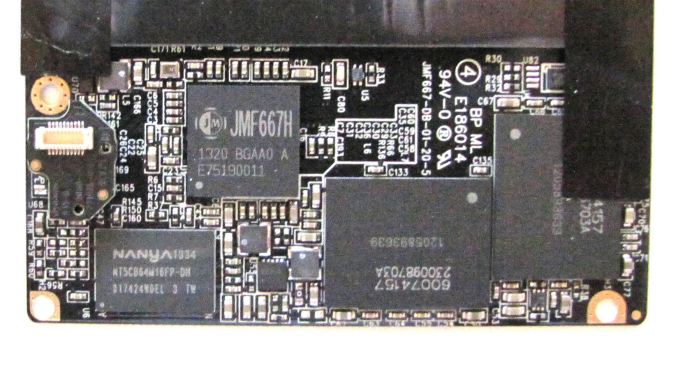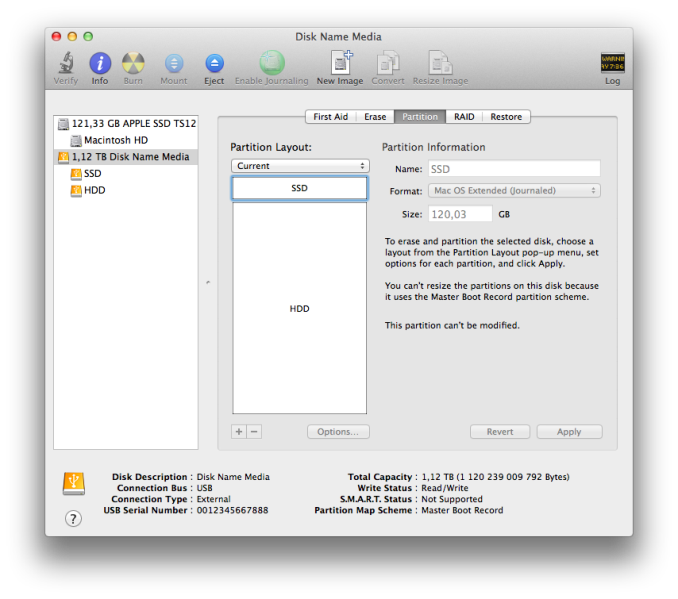The WD Black2 Review: World's First 2.5" Dual-Drive
by Kristian Vättö on January 30, 2014 7:00 AM ESTThe Drive
The Black2 consists of a 120GB SSD and 1TB dual-platter 5400rpm hard drive. It's not a hybrid drive (or SSHD) by definition like the Momentus XT because there's no caching involved. The SSD and hard drive appear as separate partitions, giving the end-user the power to decide what data goes to the SSD and what doesn't. WD calls the Black2 a dual-drive, which is a logical name for the drive because it's fundamentally two drives in one.
(Sorry for the poor quality photos -- I no longer have access to the DSLR I used before)
| WD Black2 Specifications | |
| Interface | SATA 6Gbps |
| Sequential Read | 350MB/s |
| Sequential Write | 140MB/s |
| Power Consumption | 0.9W (idle/standby) / 1.9W (read/write) |
| Noise | 20dBA (idle) / 21dBA (seek) |
| Warranty | 5 years |
| Price | $299 |
Included in the retail package is a USB 3.0 to SATA adapter and Acronis True Image WD Edition (via download) for easy data migration. There is no driver disc to my surprise but a small USB drive, which when plugged in runs a command that sends you to WD's download page (i.e. the actual drivers have to be downloaded).
Internally the drive is rather unique. The hard drive itself is the same as WD's Blue Slim model (7mm dual-platter 5400rpm drive) but in addition to the hard drive, there are two PCBs. The bigger PCB contains the SSD components (controller, NAND, DRAM) and the smaller one is home to Marvell's bridge chip, which allows the SSD and hard drive to utilize the same partition table.
WD went with a rather rare JMicron JMF667H controller in the Black2. It's a 4-channel controller and is based on the ARM9 instruction set, but as usual JMicron doesn't provide much in the way of public details.
JMicron used to be a fairly big player in the consumer SSD space back in ~2009 but the lack of a SATA 6Gbps controller pushed SSD OEMs to go with other manufacturers. The JMF667H isn't JMicron's first SATA 6Gbps controller, although it seems that all the members of JMF66x family are mostly the same with a few tweaks. I've seen the JMF66x controllers used in some Asian brand SSDs (e.g. Transcend SSD740) but the biggest demand for JMF66x has been in the industrial SSD side.
As for the NAND, WD has only disclosed that the NAND is 20nm MLC, suggesting that we're dealing with IMFT NAND (Micron or Intel). I tried googling the part numbers but it appears that the NAND is custom packaged as there was no data to be found. However, I'm guessing we're dealing with 64Gb dies, meaning eight dies (64GB) per package. There's also a 128MB DDR3-1600 chip from Nanya, which acts as a cache for the JMF667H controller.
Setting Up the Black2
When the Black2 is first connected, it appears as a 120GB drive and gaining access to the 1TB hard drive portion requires driver installation. The reason why the driver is required is due to the limits of the SATA protocol. Connecting two drives to a single SATA port would require port multiplication, which isn't supported by all SATA controllers as it's not an official requirement. Most modern SATA controllers do support port multiplication but for instance older Intel and nVidia chipsets don't. It's always better to play it safe and not have any specific hardware requirements, especially as most people have no idea what chipset is in their system.
Once the drivers have been installed, the Black2 will show up as a single drive with two partitions. The way this works is pretty simple. Operating systems use Logical Block Addresses (LBAs) for read/write commands, which are used to keep the data seen in the OS and the data in the drive in sync. As OSes have been designed with hard drives in mind, they use linear addressing, meaning that the LBAs start from 1 (i.e. the outer circle of the hard drive) and increase linearly as more data is written. Partitions are based on LBA ranges and as some of you might remember (and may still do it), splitting a hard drive into two partitions was a way to increase performance because the first partition would get the earliest LBAs with the highest performance.
In the Black2, the earliest LBAs (i.e. 120GB) are assigned for the SSD partition, whereas the rest are for the hard drive. The Marvell chip keeps track of all the LBAs and then sends data to the SSD or hard drive based on the LBA.
Out of interest, I also tried creating a 1120GB volume to see how the drive reacts. It certainly works and I was able to read and write data normally, but the issue is that you lose control of what goes to the SSD and what doesn't. As the earliest LBAs have been assigned to the SSD, the SSD will be filled first and once 120GB has been written the drive moves to writing to the hard drive, meaning that you are pretty much left with the hard drive for anything write related. If you go and delete something that's in the SSD, the next writes will go those SSD LBAs so in theory you could use the Black2 as a single volume drive, but it wouldn't be efficient in any way.
Unofficial Mac Support
The drivers WD provides are Windows only but there is a way, at least in theory, to use the drive in OS X. You need Windows access for this and what you do is set up the partitions in Windows and then use OS X's Disk Utility to format the partitions from NTFS to HFS.
Unfortunately I don't have a Mac with USB 3.0 port to thoroughly test the Black2 in OS X, so this is merely a heads up that it may work. I was able to read and write to the drive normally but without a faster interface I can't test that the writes are indeed going to the SSD when they should be. In theory yes, but it's possible that the drivers include more than just an automated partition set up.
Test System
| CPU | Intel Core i5-2500K running at 3.3GHz (Turbo and EIST enabled) |
| Motherboard | AsRock Z68 Pro3 |
| Chipset | Intel Z68 |
| Chipset Drivers | Intel 9.1.1.1015 + Intel RST 10.2 |
| Memory | G.Skill RipjawsX DDR3-1600 4 x 8GB (9-9-9-24) |
| Video Card | Palit GeForce GTX 770 JetStream 2GB GDDR5 (1150MHz core clock; 3505MHz GDDR5 effective) |
| Video Drivers | NVIDIA GeForce 332.21 WHQL |
| Desktop Resolution | 1920 x 1080 |
| OS | Windows 7 x64 |
Thanks to G.Skill for the RipjawsX 32GB DDR3 DRAM kit
















100 Comments
View All Comments
Crocodile2014 - Wednesday, February 5, 2014 - link
The Seagate Hybrid Drive could have been epic... it could have taken the market by storm... but it didn't. WHY? Because they overpriced the thing out of the market.A 500Gb Seagate Hybrid drive should have been priced very similar to a 500Gb Hard Drive + 8Gb of NAND. Instead we got a device priced at the level of a 500Gb Drive with a 30Gb SSD. Why did they do this?
I get you pay a "performance premium" but when the alternatives for better performance are cheaper, you've really missed the mark.
I suspect this drive by WD will also be a fail except for OEM's wanting a smaller package for their ultrabooks also based on the price.
SDKat - Friday, February 7, 2014 - link
Amazon has a best price of almost $300 for a 1TB HD with 120 gb SSD.FAR cheaper (by about half) to buy a 1 TB HD and separate SSD. AND more versatile too!
coder111 - Friday, February 7, 2014 - link
On scale of 1 to 10, how useless is this drive on Linux? If it needs special drivers to work properly, are these drivers available in Linux? Since which kernel version? Are they open-source or a buggy binary blob?If it works with Linux, does it show up as 2 separate drives, or as 1 combined accelerated drive? If it's 1 combined accelerated drive, how does the performance compare to having dedicated SSD + dedicated hard drive combined using Linux BCache or dm-cache?
ivan256 - Wednesday, February 12, 2014 - link
The Momentus XT is the least reliable hard drive I have ever experienced. The various iterations of it haven't improved on the situation much. I have seen failure rates of more than 50% in 18 months out of a sample size of hundreds of drives.The NAND wears out way sooner than it should. Failure isn't catastrophic, because there is a copy on the rotating media, but the NAND access failures slow the drive down to a more pathetic level than you would expect even from the slow legacy portion of the disk.
They need to get the reliability up to be taken seriously. And then they need to pair the tiny amount of flash with a much faster disk.
Haravikk - Monday, March 3, 2014 - link
I just don't get the point of these drives at all; okay, so putting the two drives into one bundle is neat, but the fact that you need software to actually run it is just bewildering. Why not include hardware on the disk to manage the split between SSD and HDD, and just let users configure that as either a SATA multiplier (two disk) or a hybrid disk as desired? Shipping it as a hybrid as standard would not only make it compatible with Linux and Mac computers too, but also make things so much easier.Instead you're getting two, not every good, individual disks in a single package. I mean, 350mb/sec sequential read is decent, but hardly amazing, plus that's competing with traffic going to the HDD at the same time.
It just seems a very messy way to produce a product that I'm not sure many people really need. I'd personally rather go with a (much cheaper) hybrid drive, assuming one 2.5" drive is all I can fit. While 8gb flash gives far from the hybrid SSD performance advertised, it's just so much simpler to setup and manage (no juggling of separate volumes) and works pretty well in real-world use.
A shame, I got really excited thinking WD were making a hybrid with 128gb of flash, i.e - something that would actually be really useful.
danwat1234 - Sunday, January 25, 2015 - link
I don't think the SATA protocol allows for more than 1 drive per channel. So, the drive couldn't have been designed to act as 2 separate drives to the controller.BDProductions - Thursday, May 1, 2014 - link
I have to wonder at the author's comment about his photos..WTF do you need a DSLR for to take great images?
Ever hear of a scanner?
- Set item on glass, cover with black velour, scan, instantly AWESOME images. (you may choose another solid color to cover the item, or even turn out the lights instead when you scan)
Some scanners do better than others for material not touching the glass, but most look better than the pictures in this article...
I have a question nobody seems to address... WHY IS THERE A MANDATORY DOWNLOAD instead of just putting the drivers on the USB thumbdrive? That makes no sense, other than to FORCE you to register the drive with WD.
That will keep me from buying such a product.
How stupid is it to make such an artificial requirement when a person might want to install the drive in a remote location where not even a cellular data connection would work? Just because anyone reading this has no such worry does not validate their theory that everyone these days MUST have an internet connection where ever they are... that just isn't true.
Some users may have remote locations with little more than power, and still NEED a replacement drive with the Black2's functionality for performance reasons.
Anyway, who has installed one and been able to save the "drivers" downloaded from WD at install time?
If you can save them, how big is the package, and why would it not make sense to have included the driver on the thumbdrive instead of a forced download?
Thanks,
Eric
bungle2000 - Tuesday, December 9, 2014 - link
Has there ever been a review of the Toshiba (500Gb/8Gb) Hybrid HDD SSD Drives on AnandTech?danwat1234 - Sunday, January 25, 2015 - link
It's down to $130 on Amazon/Newegg/Ebay! Now it's a great buy. Wish it had a 7200RPM drive thoughAseries - Friday, February 20, 2015 - link
I have two HP gaming laptops that have a mSATA slot with a 32 GB micro SSD installed running Raid 0 with the a 7200 RPM drive using Intel Rapidstore driver. Two years ago it was a reasonable solution. Laptop #1 has two 7200 RPM 1 TB drives in the two drive bays available. Today I would use a 240 GB SSD drive paired with the largest available 2.5 inch 5400 RPM drive. Laptop #2 has only one drive bay. Without the mSATA option I would definitely consider the WD solution.